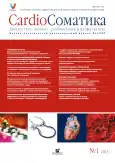Methodological issues in the organization and implementation of outpatient rehabilitation exercise programs in patients with different forms of coronary heart disease
- Authors: Aronov D.M1
-
Affiliations:
- State Research Center for Preventive Medicine, Ministry of Health of the Russian Federation
- Issue: Vol 4, No 1 (2013)
- Pages: 23-28
- Section: Articles
- URL: https://journals.rcsi.science/2221-7185/article/view/45004
- DOI: https://doi.org/10.26442/CS45004
- ID: 45004
Cite item
Full Text
Abstract
Full Text
##article.viewOnOriginalSite##About the authors
D. M Aronov
State Research Center for Preventive Medicine, Ministry of Health of the Russian Federationд-р мед. наук, проф., засл. деят. науки РФ, рук. лаб. кардиологической реабилитации ФГБУ ГНИЦ ПМ Минздрава РФ
References
- Braunwald E. Heart disease. A text book of cardiovascular medicine WB Saunders Company. Philadelphia, London, Montreal Sydney, Tokyo 1996.
- Аронов Д.М., Шарфнадель М.Г. Сравнительная оценка эффективности различных методов физических тренировок больных, перенесших инфаркт миокарда. Бюллетень ВКНЦ, 1985; 2: 76–81.
- Аронов Д.М. и др. Реабилитация больных, перенесших инфаркт миокарда, на диспансерно - поликлиническом этапе. М., 1983.
- , ACCF/AHA/ACP/AATS/PCNA/SCAI/STS Guideline for the Diagnosis and Management of Patients with Stable Ischemic Heart Disease. J Am Coll Cardiol 2012; 60 (24).
- Goble A.J., Hare D.L., Macdonald P.S. et al. Effect of early programmes of high and low intensity exercise on physical performance after transmural acute myocardial infarction. Br Heart J 1991; 65: 126–31.
- Goble A.J., Worcester M.U.C. Best practice guidelines for cardiac rehabilitation and secondary prevention: a synopsis Department of Human Services Victoria 1999.
- Аронов Д.М. и др. Влияние физических тренировок на физическую работоспособность, гемодинамику, липиды крови, клиническое течение и прогноз у больных ишемической болезнью сердца после острых коронарных событий при комплексной реабилитации и вторичной профилактике на амбулаторно - поликлиническом этапе (Российское кооперативное исследование). Кардиология. 2009; 3: 49–56.
- O’Connor C.M., Califf R.M., Massey E.W. et al. Stroke and acute myocardial infarction in the thrombolytic era: clinical correlates and long - term prognosis. J Am Coll Cardiol 1990; 3: 533–40.
- Taylor R.S. et al. Exercise - based rehabilitation for patients with coronary heart disease: review and metaanalysis of randomized controlled trials. Am J Med 2004; 116: 10.
- Schuler G, Hambrecht R, Schliert G et al. Regular physical exercise and low - fat diet. Effects on progression of coronary artery disease. Circulation 1992; 86 (1): 1–11.
- Niebauer J, Velich T, Hambrecht D.R. et al. 6 years of intensive physical exercise and low fat diet: effects on progression of coronary artery disease. Circulation 1995; 92 (Suppl. 1): 398.
- Hambrecht R, Wolf A, Gielen S et al. Effect of exercise on coronary endothelial function in patients with coronary artery disease. N Engl J Med 2000; 342: 454–60.
- Belardinelli R, Paolini I, Cianci G et al. Exercise training intervention after coronary angioplasty: the ETICA trial. J Am Coll Cardiol 2001; 37 (7): 1891–900.
- Shephard R.J., Balady G.J. Exercise as cardiovascular therapy. Circulation 1999; 99: 963–72.
Supplementary files







